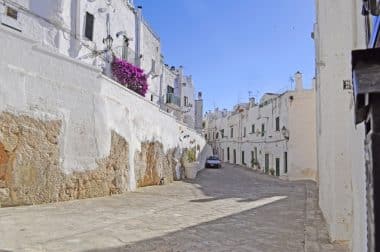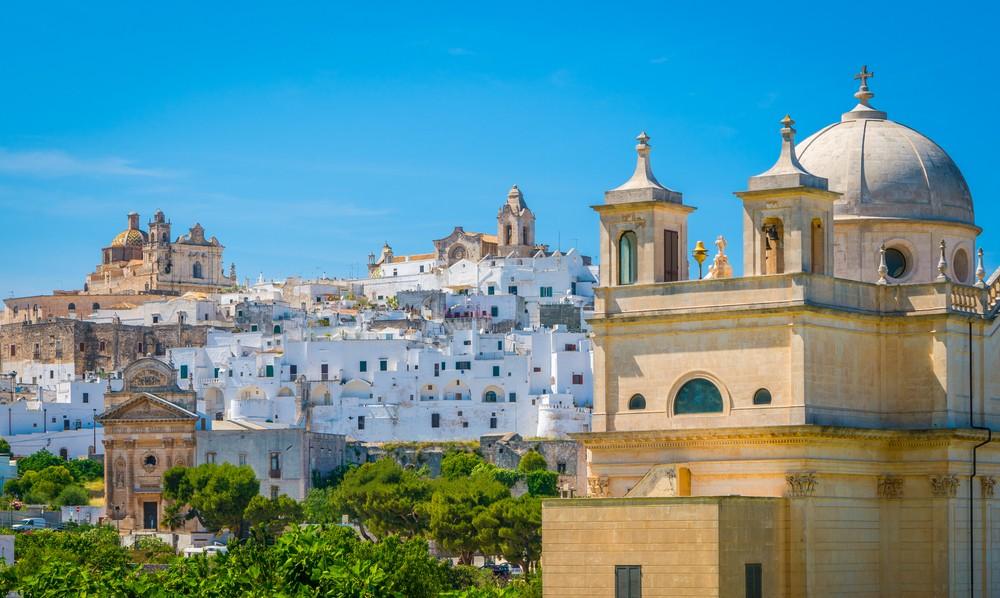Eight kilometres from the Adriatic coast, Ostuni presents itself to its visitors all in white. Even from afar, the city on a hill catches the eye, whose old town is very picturesque due to the exclusively whitewashed houses.
Ostuni promises a relaxing holiday, because the dreamlike small town in the Apulia region is a real gem. The unique old town represents the magical originality of Italy, which is worth enjoying.
A stroll through the city’s history
Anyone who walks through the wonderful maze of narrow streets today also walks through the history of the country. A first settlement in the area of today’s small town is classified in the Paleolithic Age, as confirmed by finds in the Grotta di Agnano. In the course of history, a settlement of the Messapians was destroyed by the legendary Hannibal.
Under Greek rule, a new city was built and later the Normans ruled over the city. At that time, the first features of the city as we know it today developed. So the castle was built on the summit and also the imposing city wall, which has been preserved to this day. Particularly formative was the influence of Isabella Sforza, the wife of the famous Gian Galeazzo Sforza, during the Italian Renaissance period and later the influence of her daughter Bona Sforza. This was considered very generous towards the citizens and had the towers built along the coast as protection, which have been preserved to this day.
One of the most impressive and important squares is Piazza della Libertà, which is not only considered the center of the old town, but is also located on the border with the more modern part of Ostuni. Around the piazza, numerous outdoor cafés and restaurants invite you to linger. Today’s town hall is also located on the square, which is housed in a former Franciscan monastery building that is well worth seeing. The well-preserved Oronzo Column is particularly worth seeing.
Ostuni’s old town is also characterized by numerous sacred buildings, all of which are well worth seeing. The Cathedral of Santa Maria Assunta is not only a wonderful photo motif, but also an impressive Renaissance building with late Romanesque and Gothic elements that give the church a unique flair.
Ostuni – Enjoyment in an authentic Mediterranean ambience

Ostuni is a manageable city, but this is exactly what makes it so appealing. Surrounded by rolling hills, olive groves, vineyards and fabulous views of the deep blue sea, the city is the epitome of Mediterranean ambience. In this environment, it is not only easy to relax under azure skies, but also to enjoy the delicacies of the region. Whether after a trip to the Chiesa delle Moncelle (an excavation site with finds from the Stone Age) or after a shopping spree in the old town with an excellent glass of red wine and fresh Italian food, the evenings in Ostuni’s old town alleys can also be enjoyed in a very special way under the sky of Puglia.
Travel information for Ostuni: The “white city” of Puglia
1. Arrival
- By plane: The nearest airport is Brindisi (about 30 km away). Alternatively, Bari Airport (about 80 km away) is an option.
- By car: Ostuni is easily accessible via the SS379 expressway, which connects Brindisi and Bari.
- By train: Ostuni has a train station that is connected to the regional rail network. Regular trains run from Bari, Brindisi and Lecce.
2. Best time to travel
- Spring (April to June): Mild temperatures, blooming landscapes and fewer tourists.
- Summer (July to August): Perfect for beach holidays, but hot and with more tourists.
- Autumn (September to October): Pleasant temperatures and harvest time in the region.
- Winter (November to March): Quieter and cool, ideal for relaxed city breaks without the crowds.
3. Accommodation
- Hotels and Resorts: Ostuni offers many charming boutique hotels, often housed in historic buildings.
- Masseries: Puglia’s typical, restored country estates offer luxurious accommodation with a pool and often their own olive oil production.
- Vacation rentals: A good option for families or longer stays.
4. Places of interest
- Ostuni Old Town: A maze of white, winding streets that lead to the Cathedral of Santa Maria Assunta.
- Ostuni Cathedral: A masterpiece of Gothic-Romanesque architecture with an impressive rose window.
- Piazza della Libertà: The central square with the impressive Colonna di Sant’Oronzo.
- Beaches: The coast of Ostuni is only about 8 km away. The most popular beaches are Torre Pozzelle and Rosa Marina.
- Santa Maria di Agnano Archaeological Park: A historic site where prehistoric remains were discovered.
5. Activities
- Food Tours: Taste Apulian specialties such as orecchiette, burrata, and fresh olive oil.
- Wine tastings: Visit local wineries and taste the Apulian Primitivo or Negroamaro.
- Cycling and walking tours: Explore the countryside with its olive groves and dry stone walls.
- Boat tours: Discover the Adriatic coast by boat and enjoy the view of the crystal clear waters.
6. Practical tips
- Language: Italian is the official language. Many locals speak English, especially in tourist areas.
- Currency: Euro (€). Card payment is widespread, but it is advisable to carry cash for smaller amounts.
- Clothing: In summer, light clothing, but also a hat and sunscreen because of the strong sunlight.
- Rental car: Recommended to explore the region flexibly.
7. Local festivals and events
- Sagra dei Vecchi Tempi (June): A traditional festival with dance, music and local cuisine.
- Ferragosto (15 August): An important festival in Italy with fireworks and celebrations.
- Festa di Sant’Oronzo (26 August): in honour of the patron saint of Ostuni, with processions and cultural events.
Können wir Ihnen helfen?
Benötigen Sie Unterstützung bei Ihrer Reiseplanung oder weitergehende Informationen zu einzelnen Reisezielen? Wir freuen uns über Ihre Kontaktaufnahme.


